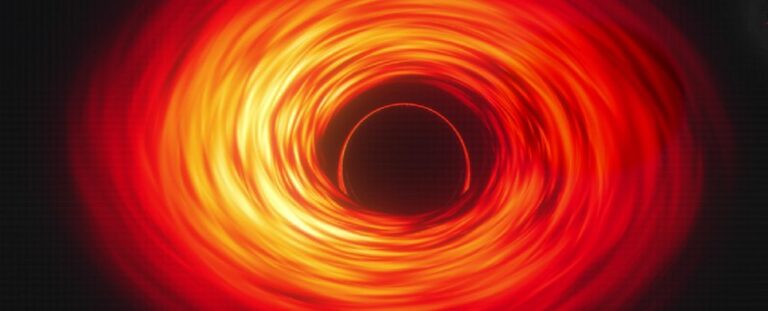The most voracious black hole ever discovered devours an entire sun on a daily basis.
The supermassive black hole located at the core of the quasar galaxy J0529-4351 is consuming an impressive amount of material, devouring approximately the equivalent of a Sun’s worth of gas and dust every day. This black hole, already boasting a mass of around 17 billion Suns, is the most voracious one observed so far, according to a group of astronomers led by Christian Wolf from the Australian National University. Its rapid growth is nearing the maximum limit of material it can intake.
This discovery provides a unique opportunity to study the growth and evolution of supermassive black holes at the extreme end of the scale. It also serves as a remarkable example of the awe-inspiring nature of these cosmic entities.
Supermassive black holes are truly fascinating entities, with masses ranging from millions to billions of times that of the Sun. They are typically found at the centers of galaxies, exerting immense gravitational influence over their surroundings.
The formation of these colossal black holes remains a mystery. While smaller black holes can form from the collapse of massive stars, the process is not efficient enough to explain the existence of supermassive black holes, especially in the early stages of the Universe.
By studying actively growing supermassive black holes like the one in J0529-4351, scientists hope to gain insights into the mechanisms responsible for their immense size. Quasars, such as J0529-4351, provide valuable opportunities to observe and analyze these cosmic phenomena.
Version 1: Positioned at the core of an immense, tumultuous, and spinning accumulation of matter, the black hole is encompassed by a swirling mass that steadily flows into it, akin to water spiraling down a drain.
As a result of the immense friction and gravitational forces, this matter becomes intensely heated, reaching temperatures of billions or even trillions of degrees, radiating luminously across the expanse of space in a wide range of wavelengths. By meticulously dissecting this emitted light, astronomers are able to scrutinize and deduce the characteristics and attributes of the black hole.

J0529-4351, a quasar discovered during the Cosmic Noon approximately 1.5 billion years after the Big Bang, represents a significant milestone in the early stages of the Universe. The immense mass of this quasar, estimated to be between 17 and 19 billion times the mass of the Sun, poses a challenge for comprehension, although it is not the heaviest ever observed.
To gain insight into its colossal size, researchers have examined the rate at which the black hole within the quasar consumes matter. Their calculations indicate that the black hole is growing at a rate of approximately 370 solar masses per year. This means that each day, the black hole accumulates a mass slightly greater than that of the Sun.
Considering the mass of the black hole, this growth rate is remarkably close to the Eddington limit, which represents the maximum stable rate at which a black hole can feed. While a black hole can briefly experience super-Eddington accretion, at such high rates, the intense radiation pressure causes the material surrounding the black hole to be pushed away until it is beyond the reach of gravity.
Consequently, the black hole powering J0529-4351 is expanding at its maximum potential. Many other quasars also exhibit black holes that approach Eddington accretion, but J0529-4351 stands out as the most luminous and voracious supermassive black hole observed thus far.
The researchers state, “In terms of luminosity and likely growth rate, J0529-4351 is the most extreme quasar known.”
Despite these remarkable findings, there is still much that remains unknown about J0529-4351. The mechanisms behind its massive accretion have yet to be determined. A more detailed investigation utilizing the Atacama Large Millimeter/Submillimeter Array in Chile could provide insights into the movement of gas within the galaxy and the rotation of the galaxy itself. Additionally, the team hopes to discover other extreme quasars hidden in the distant corners of space and time.
While these objects’ extreme examples are uncommon, Wolf and his colleagues are convinced that there are additional ones waiting to be found in the vast and marvelous cosmos.
The research has been published in Nature Astronomy.
Do not forget to share your opinion with us to provide you with the best posts !




0 Comments